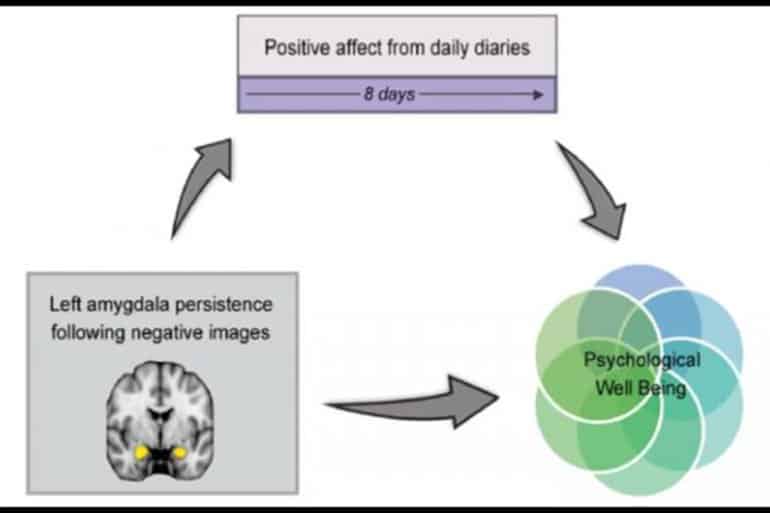Summary: A new study reveals activity in the amygdala remains consistent when a person views neutral stimuli following viewing negative stimuli. The persistent activity increased negative mood and decreased positive feelings.
Source: SfN
How the amygdala responds to viewing negative and subsequent neutral stimuli may impact our daily mood, according to new research published in Journal of Neuroscience.
The amygdala evaluates the environment to find potential threats. If a threat does appear, the amygdala can stay active and respond to new stimuli like they are threatening too.
This is helpful when you are in a dangerous situation, but less so when spilling your coffee in the morning keeps you on edge for the rest of the day.
In a recent study, Puccetti et al. examined data collected from the “Midlife in the US” longitudinal study. Participants completed a psychological wellbeing assessment and eight daily telephone interviews to assess their mood. They also came into the lab for an fMRI task: they viewed negative, positive, and neutral images with a picture of a neutral facial expression in between each image.

When the amygdala activated in a similar pattern as the participants viewed negative images and the neutral faces that followed, this persistent activity predicted increases in negative daily mood and decreases in positive daily mood. In turn, participants who experienced increased positive mood displayed greater psychological wellbeing.
These results suggest amygdala activity influences how a person feels day-to-day, which can impact overall psychological wellbeing.
About this neuroscience research mood
Source: SfN
Contact: Calli McMurray – SfN
Image: The image is credited to Puccetti et al., JNeurosci 2021
Original Research: Closed access.
“Linking Amygdala Persistence To Real-World Emotional Experience and Psychological Well-Being” by Nikki A. Puccetti, Stacey M. Schaefer, Carien M. van Reekum, Anthony D. Ong, David M. Almeida, Carol D. Ryff, Richard J. Davidson and Aaron S. Heller. Journal of Neuroscience
Abstract
Linking Amygdala Persistence To Real-World Emotional Experience and Psychological Well-Being
Neural dynamics in response to affective stimuli are linked to momentary emotional experiences. The amygdala, in particular, is involved in subjective emotional experience and assigning value to neutral stimuli. Because amygdala activity persistence following aversive events varies across individuals, some may more readily evaluate subsequent neutral stimuli than others. This may lead to more frequent and long-lasting momentary emotional experiences, which may also be linked to self-evaluative measures of psychological well-being (PWB). Despite extant links between daily affect and PWB, few studies have directly explored the links between amygdala persistence, daily affective experience, and PWB.
To that end, we examined data from 52 human adults (67% female) in the Midlife in the United States (MIDUS) study who completed measures of PWB, daily affect, and functional MRI (fMRI). During fMRI, participants viewed affective images followed by a neutral facial expression, permitting quantification of individual differences in the similarity of amygdala representations of affective stimuli and neutral facial expressions that follow.
Using representational similarity analysis (RSA), neural persistence to aversive stimuli was operationalized as similarity between the amygdala activation patterns while encoding negative images and the neutral facial expressions shown afterward. Individuals demonstrating less persistent activation patterns in the left amygdala to aversive stimuli reported more frequent positive and less frequent negative affect (NA) in daily life. Further, daily positive affect (PA) served as an indirect link between left amygdala persistence and PWB.
These results clarify important connections between individual differences in brain function, daily experiences of affect, and well-being.
SIGNIFICANCE STATEMENT
At the intersection of affective neuroscience and psychology, researchers have aimed to understand how individual differences in the neural processing of affective events map onto to real-world emotional experiences and evaluations of well-being.
Using a longitudinal dataset from 52 adults in the Midlife in the United States (MIDUS) study, we provide an integrative model of affective functioning: less amygdala persistence following negative images predicts greater positive affect (PA) in daily life, which in turn predicts greater psychological well-being (PWB) seven years later.
Thus, day-to-day experiences of PA comprise a promising intermediate step that links individual differences in neural dynamics to complex judgements of PWB.







